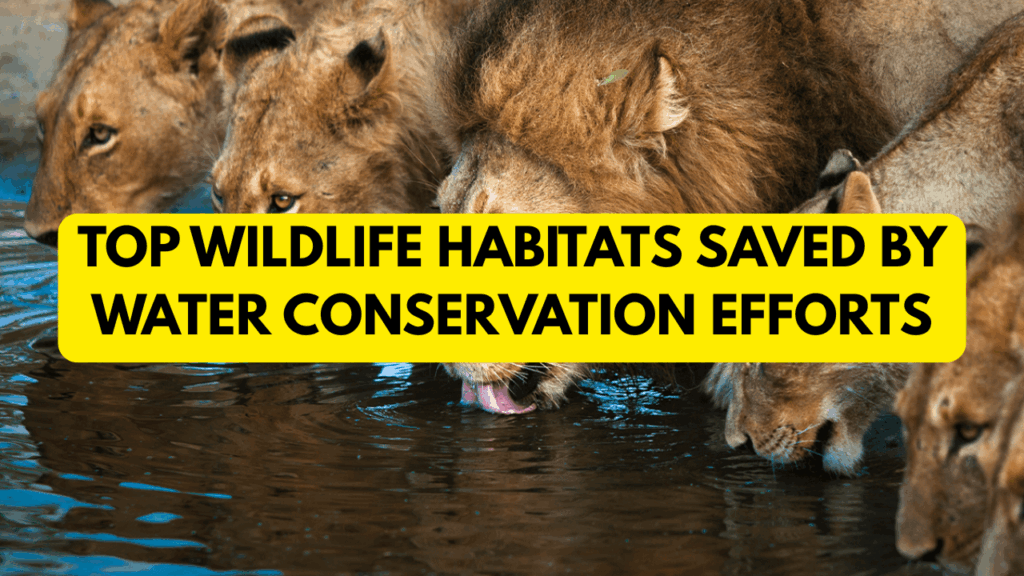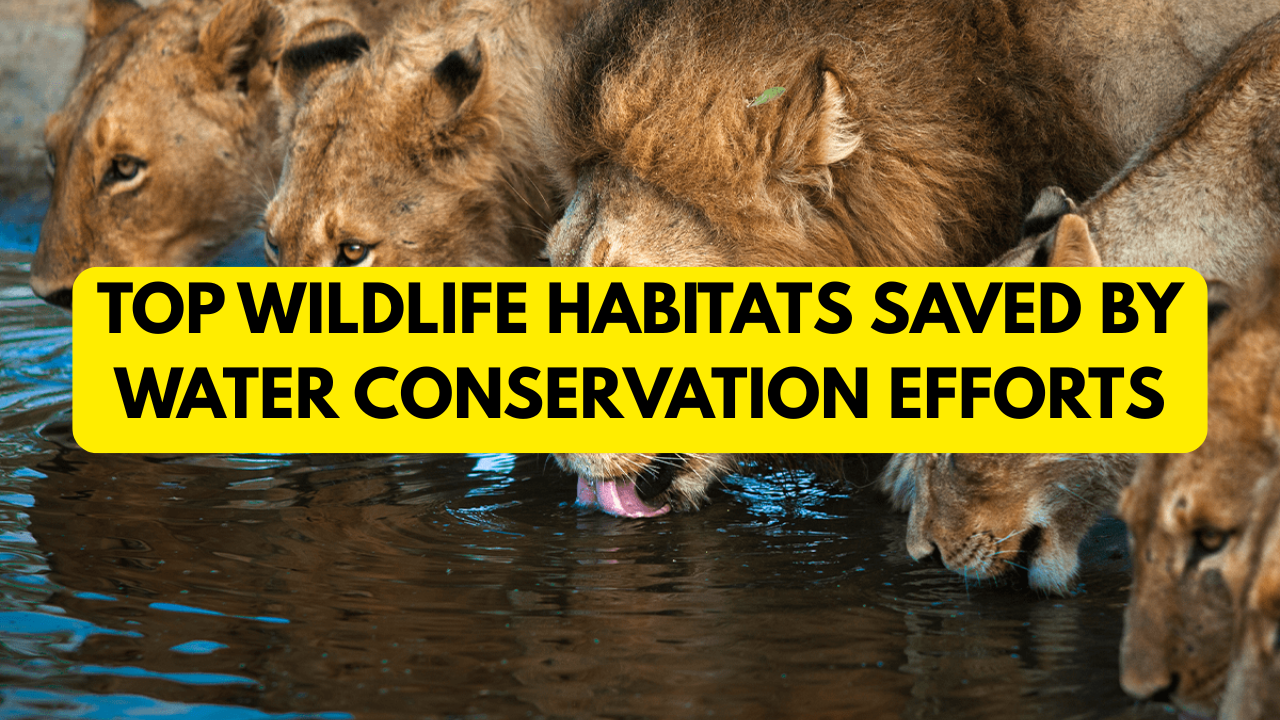
Water is the foundation of life, and nowhere is this more evident than in the habitats where wildlife thrives. From wetlands and forests to coral reefs and deserts, every ecosystem depends on healthy water supplies to survive. As climate change, pollution, and over-extraction threaten freshwater resources, water conservation has emerged as a powerful tool to protect both biodiversity and human well-being.
This article explores the top wildlife habitats saved by water conservation efforts, the specific benefits of protecting them, and the lessons they hold for future conservation.
Why Water Conservation Matters for Wildlife
Water conservation goes beyond reducing household consumption—it safeguards ecosystems that countless species call home. Key benefits include:
- Maintaining biodiversity – Healthy water systems support thousands of plant and animal species.
- Preventing habitat loss – Conserved rivers, wetlands, and forests retain their ecological balance.
- Strengthening climate resilience – Protected water ecosystems regulate temperatures, store carbon, and prevent droughts.
- Supporting migration routes – Rivers, wetlands, and estuaries act as stopovers for migratory birds and fish.
- Protecting human livelihoods – Many communities rely on the same habitats for agriculture, fishing, and water supply.
Top Habitats Saved by Water Conservation
1. Wetlands – Cradles of Biodiversity
Wetlands filter water, prevent floods, and act as nurseries for fish, amphibians, and birds. Conservation projects in regions like the Florida Everglades and India’s Chilika Lake have restored wetland health, bringing back bird populations and fish diversity.
2. Coral Reefs – Underwater Cities
Reefs depend on clean water free of excess sediments and pollutants. Water conservation reduces runoff and prevents nutrient overload that causes coral bleaching. Efforts in the Great Barrier Reef have shown that reducing agricultural runoff improves reef resilience.
3. Forests and River Basins – Nature’s Water Towers
Forests regulate rainfall, store groundwater, and protect rivers. Conserving river basins like the Amazon and Congo ensures not only water security but also the survival of jaguars, gorillas, and countless bird species.
4. Deserts and Arid Regions – Fragile Ecosystems
Even deserts rely on water conservation. Protecting scarce water sources helps wildlife like camels, desert foxes, and reptiles survive. Efforts in African and Middle Eastern deserts focus on sustainable water management to keep fragile oases alive.
5. Mountain Ecosystems – Sources of Freshwater
Glaciers and mountain rivers provide fresh water for billions of people and species. Conservation of the Himalayas and Andes ensures habitats for snow leopards, Andean condors, and alpine vegetation while sustaining global river systems.
6. Rivers and Floodplains – Lifelines of Civilization
Healthy rivers are critical for species like salmon, otters, and migratory birds. Conservation programs in the Mekong, Ganges, and Mississippi aim to restore natural flows, reduce dam impacts, and protect river-dependent species.
Table: Habitats and Their Conservation Benefits
| Habitat | Wildlife Supported | Conservation Benefit |
|---|---|---|
| Wetlands | Fish, amphibians, migratory birds | Filters water, prevents flooding |
| Coral reefs | Fish, turtles, marine mammals | Protects coastlines, supports fisheries |
| Forest river basins | Big cats, primates, birds | Regulates rainfall, prevents erosion |
| Deserts & arid zones | Camels, desert foxes, reptiles | Sustains rare oases, prevents desertification |
| Mountain ecosystems | Snow leopards, condors, alpine flora | Secures global freshwater supply |
| Rivers & floodplains | Salmon, otters, waterfowl | Maintains biodiversity, natural flow systems |
Success Stories in Habitat Protection
- Ramsar Wetland Sites – Over 2,400 wetlands across the globe are now protected under the Ramsar Convention, ensuring migratory birds and amphibians have safe habitats.
- Great Barrier Reef Action Plan – By improving water quality, coral reef habitats have shown signs of recovery despite climate challenges.
- Amazon Basin Initiatives – Reforestation and river conservation projects are helping stabilize rainfall cycles critical to both wildlife and agriculture.
- Mekong River Cooperation – Regional agreements aim to balance hydropower needs with fish migration and biodiversity protection.
Overview Table
| Action | Saved Habitat | Impact on Wildlife |
|---|---|---|
| Wetland restoration | Wetlands | Boosts bird and fish populations |
| Reducing runoff & pollution | Coral reefs | Prevents bleaching, supports marine life |
| River basin reforestation | Forest rivers | Protects mammals, birds, and soils |
| Sustainable desert water use | Deserts & oases | Keeps rare species alive |
| Glacier & mountain protection | Mountain ecosystems | Secures habitats and water flows |
| Restoring natural flows | Rivers & floodplains | Protects migratory species and ecosystems |
Final Thoughts
Water conservation is not just about saving resources—it is about saving habitats and the species that depend on them. From wetlands that cradle migratory birds to coral reefs bustling with marine life, every conserved drop contributes to the protection of ecosystems.
If we want to secure a future where biodiversity thrives alongside human civilization, water conservation must remain at the heart of global environmental strategies. Protecting wildlife habitats through water conservation is not just an ecological choice—it’s a survival necessity.
FAQs
Q1: Which wildlife habitats benefit most from water conservation?
Wetlands, coral reefs, rivers, forests, deserts, and mountain ecosystems gain the most from water conservation.
Q2: How does water conservation protect biodiversity?
It preserves natural flows, reduces pollution, and sustains the ecosystems species depend on.
Q3: Can small-scale water conservation make a difference for wildlife?
Yes, even local efforts like reducing runoff, planting trees, or protecting wetlands help maintain global biodiversity.

